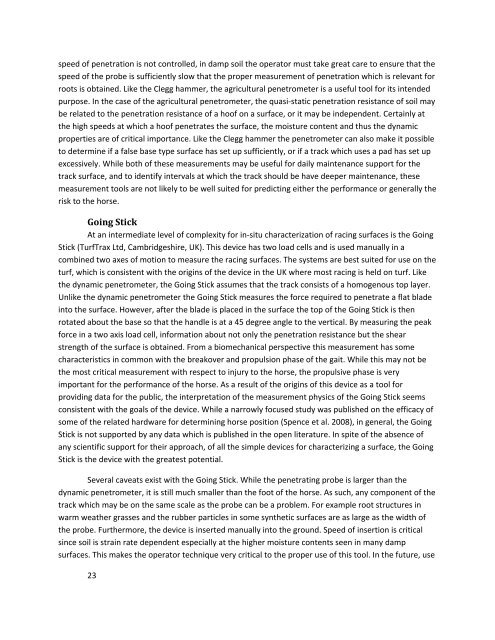Retired Racehorses
tfrr_reportandappendicesfinal
tfrr_reportandappendicesfinal
- No tags were found...
Create successful ePaper yourself
Turn your PDF publications into a flip-book with our unique Google optimized e-Paper software.
speed of penetration is not controlled, in damp soil the operator must take great care to ensure that the<br />
speed of the probe is sufficiently slow that the proper measurement of penetration which is relevant for<br />
roots is obtained. Like the Clegg hammer, the agricultural penetrometer is a useful tool for its intended<br />
purpose. In the case of the agricultural penetrometer, the quasi‐static penetration resistance of soil may<br />
be related to the penetration resistance of a hoof on a surface, or it may be independent. Certainly at<br />
the high speeds at which a hoof penetrates the surface, the moisture content and thus the dynamic<br />
properties are of critical importance. Like the Clegg hammer the penetrometer can also make it possible<br />
to determine if a false base type surface has set up sufficiently, or if a track which uses a pad has set up<br />
excessively. While both of these measurements may be useful for daily maintenance support for the<br />
track surface, and to identify intervals at which the track should be have deeper maintenance, these<br />
measurement tools are not likely to be well suited for predicting either the performance or generally the<br />
risk to the horse.<br />
Going Stick<br />
At an intermediate level of complexity for in‐situ characterization of racing surfaces is the Going<br />
Stick (TurfTrax Ltd, Cambridgeshire, UK). This device has two load cells and is used manually in a<br />
combined two axes of motion to measure the racing surfaces. The systems are best suited for use on the<br />
turf, which is consistent with the origins of the device in the UK where most racing is held on turf. Like<br />
the dynamic penetrometer, the Going Stick assumes that the track consists of a homogenous top layer.<br />
Unlike the dynamic penetrometer the Going Stick measures the force required to penetrate a flat blade<br />
into the surface. However, after the blade is placed in the surface the top of the Going Stick is then<br />
rotated about the base so that the handle is at a 45 degree angle to the vertical. By measuring the peak<br />
force in a two axis load cell, information about not only the penetration resistance but the shear<br />
strength of the surface is obtained. From a biomechanical perspective this measurement has some<br />
characteristics in common with the breakover and propulsion phase of the gait. While this may not be<br />
the most critical measurement with respect to injury to the horse, the propulsive phase is very<br />
important for the performance of the horse. As a result of the origins of this device as a tool for<br />
providing data for the public, the interpretation of the measurement physics of the Going Stick seems<br />
consistent with the goals of the device. While a narrowly focused study was published on the efficacy of<br />
some of the related hardware for determining horse position (Spence et al. 2008), in general, the Going<br />
Stick is not supported by any data which is published in the open literature. In spite of the absence of<br />
any scientific support for their approach, of all the simple devices for characterizing a surface, the Going<br />
Stick is the device with the greatest potential.<br />
Several caveats exist with the Going Stick. While the penetrating probe is larger than the<br />
dynamic penetrometer, it is still much smaller than the foot of the horse. As such, any component of the<br />
track which may be on the same scale as the probe can be a problem. For example root structures in<br />
warm weather grasses and the rubber particles in some synthetic surfaces are as large as the width of<br />
the probe. Furthermore, the device is inserted manually into the ground. Speed of insertion is critical<br />
since soil is strain rate dependent especially at the higher moisture contents seen in many damp<br />
surfaces. This makes the operator technique very critical to the proper use of this tool. In the future, use<br />
23


